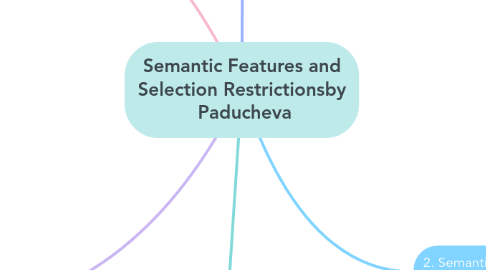
1. 1. Lexical database of the system
1.1. Lexicographer
1.1.1. expert system
1.1.2. natural language processing
1.1.3. Two basic components
1.1.3.1. Lexical database (LBD)
1.1.3.1.1. Is a vocabulary presented in a machine readable
1.1.3.1.2. The user may get information about
1.1.3.1.3. Programs give the following options
1.1.3.2. Bibliographic database (BBD)
1.1.3.2.1. Vocabulary
1.1.3.2.2. Morphological
1.1.3.2.3. Syntactic and semantic
1.1.3.2.4. Contains bibliographic information
2. 2. Semantic feature according to U.Weinreich
2.1. is associated with U. Weinreich
2.2. proposed a useful distinction between
2.2.1. paradigmatic semantic feature
2.3. Use the notion of semantic feature in a TG
2.3.1. where
2.3.1.1. semantic features are strictly opposed to syntactic
2.3.1.2. in TG, semantic features
2.3.1.2.1. are not involved
2.4. Purposes
2.4.1. it is regarded as
2.4.1.1. a basis of semantic agreement
2.4.2. it explains
2.4.2.1. deviant and metaphorical readings
2.4.3. it adds
2.4.3.1. provisional semantic contents to a potentially ambiguous word
2.5. Divide into two groups
2.5.1. Categorical feature
2.5.1.1. usually a noun
2.5.1.2. own characteristics
2.5.1.2.1. a common property
2.5.2. Transitive feature
2.5.2.1. usually a predicate
2.5.2.2. semantic condition imposed
2.5.2.2.1. on one of the arguments
3. 3. Semantic features In systems of natural language processing (NLP)
3.1. SF belong to significant NLP resources
3.2. the following problems may be listed
3.2.1. 1.
3.2.1.1. Revealing predicate-argument relations in parsing algorithms
3.2.1.1.1. categorical features
3.2.2. 2.
3.2.2.1. Disambiguation of a lexically homonymous predicate word
3.2.2.1.1. categorial feature of an argument
3.2.3. 3.
3.2.3.1. Disambiguation of a lexically homonymous noun
3.2.3.1.1. by addressing transfer features of the predicate
3.2.4. 4.
3.2.4.1. Combinability of verbs with adverbials
3.2.4.1.1. designating time, place, reason, purpose, instrument.
3.2.5. 5.
3.2.5.1. it is necessary to carry out a transformation opposite to conjunction reduction
3.2.5.1.1. semantic agreement gives a hint
3.2.6. 6.
3.2.6.1. SF may be useful in the procedures
3.2.6.1.1. to revealing anaphoric relations in text
3.2.7. 7.
3.2.7.1. Transfer semantic features may be use
3.2.7.1.1. to distinguish texts for literal interpretations
4. -
5. .
6. 4. Semantic features and selection restrictions in lexicon and grammar
6.1. Historical Development
6.1.1. Early 60s:
6.1.1.1. Semantic features were a primary tool for semantic analysis.
6.1.2. 70s and 80s:
6.1.2.1. Progress in semantic theory shifted focus away from semantic features.
6.2. Modern Perspective
6.2.1. Semantic features deserve a more prominent place.
6.2.2. Semantic features can be labels for components in lexical meaning.
6.3. Role in Selection Restrictions
6.3.1. Semantic features, not syntactic ones, may play a leading role.
6.3.2. Anna Wierzbicka's perspective:
6.3.2.1. Grammatical distinctions are motivated by semantic distinctions.
6.4. Examples of Semantically Motivated Selection Restrictions
6.4.1. Example 1: Neg-Raising Predicates
6.4.1.1. Characteristics: [+Incompatibility of contraries], [+Excluded neutrality].
6.4.2. Example 2: Russian Conjunctions
6.4.2.1. qTO after verbs with 'know/believe,' KaK after words with 'perceive.'
6.4.3. Example 3: Indirect Questions
6.4.3.1. Semantic component 'X knows' determines the semantic option.
7. .
8. .
9. -
10. 5. On semantic invariant of the class of words with genitive subject
10.1. Apresjan 1985's Claim
10.1.1. The choice of the case of the subject
10.1.1.1. is determined by
10.1.1.1.1. a syntactic feature of a verb
10.2. Construction with Genitive Subject in Russian
10.2.1. Differences in Syntactic Behavior
10.2.1.1. marked with "*" indicate incorrect syntax.
10.2.2. Semantic Explanation of Subject Case Choice
10.2.2.1. Introduction of the term "genitive verbs."
10.2.2.2. Different case choices have
10.2.2.2.1. a semantic explanation.
10.3. Semantic Invariant of Genitive Verbs
10.3.1. Two semantic components
10.3.1.1. negative sentences with genitive subject construction.
10.3.1.1.1. groups of genitive verbs.
10.4. Conditions for Subject Case Exclusion
10.4.1. Semantic invariant allows
10.4.1.1. stating conditions for genitive subject exclusion.
